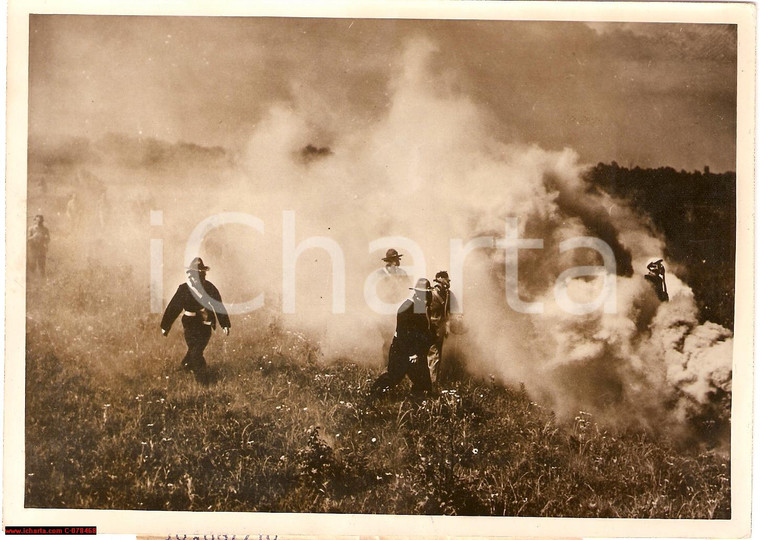
(timbro datario d'epoca al verso)
Esercitazioni di guerra chimica dell'esercito statunitense
Fotografia d'epoca con didascalia coeva dattiloscritta al verso:
"LA GUERRE DES GAZ
Les Etats-Unis possèdent à Edgewood une Ecole militaire pur la guerre des gaz.
L'entrainement des officiers à l'Ecole d'Edgewood. Masqués, ils traversent une épaisse nappe de gaz
4/ET/180739 (Keystone)"
(timbro al verso)
Vera fotografia d'epoca, originale ed autentica
Dal Time del 18 novembre 1940:
A wooded peninsula northeast of Baltimore, between the Bush and Gunpowder Rivers, is not so peaceful as it looks. Edgewood Arsenal is there. There also is the Army's Chemical Warfare School. Last week 24 National Guard officers reported there to study and practice defenses against war's most forbidding weapon. They joined 24 others in the first National Guard gas class since the Guard was mobilized for a year's field training.
In Edgewood's big classrooms, in the fields of the reservation, they will study for seven weeks the weapon that Germany first effectively introduced to modern warfare on April 22, 1915, when she turned chlorine loose on unprepared British troops at Ypres. In World War II Germany has so far used no gas, possibly because of its effect on U. S. public opinion, but her gas factories are reported working full and overtime. There is no documented proof that gas has been used in world warfare since Italian troops spewed it against barefooted Ethiopian warriors in 1936 (reported fatalities about 500). Yet gas is a potent weapon (it caused more than 1,000,000 of the 37,513,886 casualties of World War I, was responsible for about one-third of all A. E. F. hospital cases), may still be used in World War II.
On every student's desk at Edgewood hangs a brand-new gas mask, product of a factory on the reservation where 2,000 women workers hem, stitch and vulcanize masks for the expanding Army. The masks hang in the classroom both as symbols and instruments of instruction. Edgewood's students are there to learn more than how and when to don a gas mask. Of the lethal gases they learn that chlorine, phosgene and diphosgene attack a man's lungs, are soon blown away. More deadly are mustard and lewisite, which hang in wooded areas for days at a time. Against these, gas masks are only partial protection, for they attack men's bodies, produce ghastly burns. (Lewisite may also cause death from arsenic poisoning.) Helpers of the lethal gases are the sneeze, tear and vomiting gases. Used as harassing agents, they make men work in masks over long periods. Men who get a whiff of the harassing gases before they get on their masks, have to take them off, are then wide open to the killers that may follow.
Filled with such classroom lore, Edgewood students pass their examinations with their noses, must be flunked if their sense of smell is subnormal. Sniffing daintily while instructors release small concentrations of gas, they identify chemical agents by their odors. Mustard smells like garlic, lewisite like geraniums, phosgene like musty hay or green corn, tear gas like apple blossoms. No man has yet devised a war gas that is odorless. Until someone does, the nose of a battalion gas officer, sharpened at Edgewood, will still be the No. 1 defense against gas.





